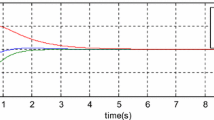Abstract
Teleoperation rendezvous and docking can be used as a backup for autonomous rendezvous and docking (RVD) for an unmanned spacecraft or for guiding the chaser docking with an uncooperative target. The inherent teleoperation time delay is a rigorous problem, especially when the chaser is teleoperated on the ground. To eliminate the effect of time delay, a new approach for teleoperation RVD is studied. The characteristics of teleoperation RVD are analyzed by comparisons with the teleoperation robot and with manually controlled RVD; the relative motion of the chaser is predicted based on the C-W equation; and the processed measure information with time delay through the Kalman filter is utilized to correct the current prediction. Experimental results verify that the approach produces an 18% enhanced success rate of teleoperation RVD compared with direct visual feedback, and consumes less time and fuel. The developed approach also solves the time delay problem effectively. Teleoperation RVD using this method can be applied as a useful backup for autonomous RVD.
Similar content being viewed by others
References
Zhou J Y, Jiang Z C, Tang G J. Conceive of the conception and investigation of teleoperator spacecraft. In: Proceedings of the 61st International Astronautical Congress. Prague: International Astronautical Federation, 2010
Jones S. Orbital maneuvering vehicle teleoperation and video data compression. AIAA J, 1989, 28(9): 99–117
Cislaghi M. The ATV rendezvous pre-development program (ARP). In: Proceedings of the 22nd AAS Guidance Control Conference. Breckenridge: ESA, 1999
Mokuno M, Kawano I. Development of ETS-VII RVD system-preiminary design and EM development phase. In: Proceedings of the AIAA Guidance, Navigation, and Control Conference. Washington: AIAA, 1995. 1656–1664
Mitsushige O. Experiences and lessons learned from the ETS-VII robot satellite. In: Proceedings of the IEEE International Conference on Robotics and Automation. San Francisco: IEEE, 2000. 914–919
Sheridan T B. Space teleoperation through time delay: Review and prognosis. IEEE Trans Robot Autom, 1993, 9(6): 592–606
Audo N, Lee J H, Hashimoto H. Study on influence of time delay in teleoperation. In: Proceedings of the IEEE International Conference on Advanced Intelligent Mechatronics. Atlanta: IEEE, 1999. 317–322
Hokayem P F, Spong M W. Bilateral teleoperation: An historical survey. Automatica, 2006, 42(12): 2035–2057
Li Y. Research on Teleoperation Through Large Time Delay and on Virtual Reality (in Chinese). Dissertation for Doctoral Degree. Changsha: National University of Defense Technology, 2002
Zhao M, Zhang H, Chen J B. Technology of VR teleoperation and its development (in Chinese). J Syst Simul, 2007, 19(14): 3248–3252
Hirzinger G, Brunner B, Dietrich J, et al. ROTEX-The first remotely controlled robot in space. In: Proceedings of the IEEE International Conference on Robotics and Automation. San Diego: IEEE, 1994. 2604–2611
Mitsushige O. System engineering approach in designing the teleoperation system of the ETS-VII robot experiment satellite. In: Proceedings of the IEEE International Conference on Robotics and Automation. New Mexico: IEEE, 1997. 3050–3061
Kawano I, Mokuno M, Horiguchi H, et al. In-orbit demonstration of an unmanned automatic rendezvous and docking system by the Japanese engineering test satellite ETS-VII. In: AIAA Guidance, Navigation, and Control Conference. Washington: AIAA, 1994. 950–960
Kawano I, Mokuno M, Kasai T, et al. Result and evaluation of autonomous rendezvous docking experiment of ETS-VII. In: Proceedings of the AIAA Guidance, Navigation, and Control Conference. Oregon: AIAA, 1999. 4073–4082
Bejczy A K, Kim W S, Venema S C. The phantom robot: Predictive displays for teleoperation with time delay. In: IEEE International Conference on Robotics and Automation. Cincinnati: IEEE, 1990. 546–551
Imaida T, Yokokohji Y, Doi T, et al. Ground space bilateral teleoperation of ETS-VII robot arm by direct bilateral coupling under 7-s time delay condition. IEEE Trans Robot Autom, 2004, 20(3): 499–511
Yoshiaki O, Kawano I. Autonomous rendezvous and docking by engineering test satellite VII: A challenge of Japan in guidance, navigation and control-break well memorial lecture. Acta Astron, 2003, 53(1): 1–8
Author information
Authors and Affiliations
Corresponding author
Rights and permissions
About this article
Cite this article
Zhou, J., Jiang, Z. & Tang, G. A new approach for teleoperation rendezvous and docking with time delay. Sci. China Phys. Mech. Astron. 55, 339–346 (2012). https://doi.org/10.1007/s11433-011-4589-1
Received:
Accepted:
Published:
Issue Date:
DOI: https://doi.org/10.1007/s11433-011-4589-1




